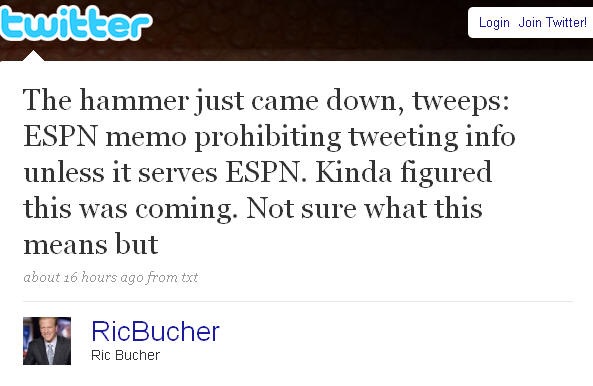
Late yesterday, ESPN basketball reporter Ric Bucher sent out the tweet above in response to a set of social networking guidelines put out by the network. The new guidelines prohibit reporters from maintaining personal websites or blogs containing sports content, require that employees get permission from a supervisor prior to participating in socnets and calls for social networking content to fall under the same editorial guidelines as other ESPN media.
The online reaction to the news has mostly focused on the idea that ESPN is a clueless giant that is needlessly limiting the freedom of its reporters. To me, the story is much more complicated than that.
A few days ago, CNNSI reporter Peter King published an anecdote in one of his columns about the dilemma he faced in breaking some news about Michael Vick and the New England Patriots. He ended up releasing the story on Twitter because he was afraid he would get scooped if he waited to post to CNNSI.
It’s a weird media world we’re in right now. My allegiance, obviously, is to SI.com, but I know if I take 10 minutes right now to dictate the item to someone on the news desk, the story will get up in 20 minutes, and we’ll probably be too late. So I decide to throw a couple of Tweets up, the first at 4:59 saying Vick wasn’t in Foxboro, and the second that the Pats don’t want Vick and like O’Connell. Sure enough, at 5:01 p.m., Adam Schefter Tweeted that Vick wasn’t in New England either. It’s a crazy media world. Forgive me, Time Warner.
If you are Time Warner (owner of CNNSI), in the situation above you are paying King to report for you and he releases breaking news on his personal Twitter account as opposed to on your website. This means you have no opportunity to monetize the story, and that some users might just start following King’s Twitter account instead of reading him on CNNSI. While it can certainly be argued that King building a large Twitter following is ultimately good for CNNSI, this kind of situation introduces complicated questions for both reporters and publishers.
I think the ESPN guidelines are an attempt to establish rules for situations like the one King faced. However clumsy they my seem, from my reading the guidelines are an effort by ESPN to exercise some editorial control over social media content, and not simply a clueless attempt to stifle their reporters. Indeed, another portion of the ESPN memo hints that ESPN has plans for fully integrating Twitter and Facebook into all its efforts, undoubtedly with an eye towards monetizing the content produced on socnets:
ESPN Digital Media is currently building and testing modules designed to publish Twitter and Facebook entries simultaneously on ESPN.com, SportsCenter.com, Page 2, ESPN Profile pages and other similar pages across our web site and mobile platforms. The plan is to fully deploy these modules this fall.
Media organizations are facing some really complicated questions here. I think in this case we are sort of watching ESPN struggle to make up the rules as they go.
Sign up today to have our latest posts delivered straight to your inbox.